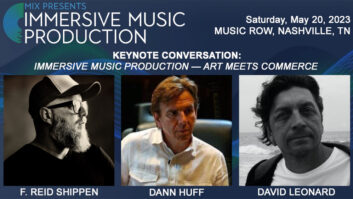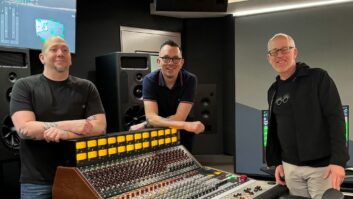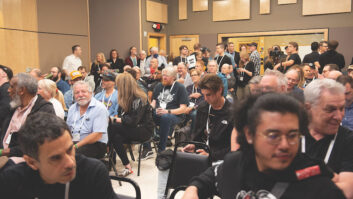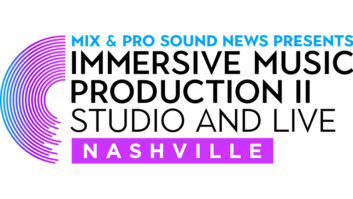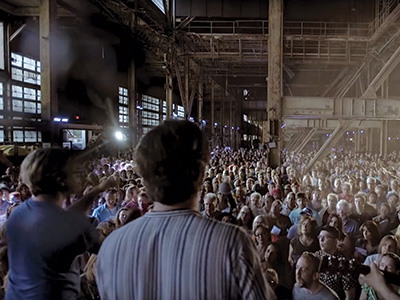
The setting: Toronto’s Luminato art festival. The venue: a gigantic, long-disused industrial building called The Hearn Generating Station. The performers: Rufus Wainwright and 1,500 volunteer, amateur singers led by conductor Nobu Adilman and guitarist Daveed Goldman from an organization called Choir! Choir! Choir! The production company: ZERO11ZERO/Iron Bay Films, led by director Byron Kent Wong. The challenge: Capture quality audio and video of the event with no previous rehearsal, limited setup and breakdown time, and heavy restrictions on gear. The song: Leonard Cohen’s “Hallelujah.”
The resultant video, available on YouTube and recorded on June 11, 2016, five months before the legendary songwriter and artist passed, captures not only great sound and visuals, but also the serene and emotional vibe of the event. What you don’t see is how challenging the conditions were for Wong and the production team.
Choir! Choir! Choir! is a self-described “singing event,” based in Toronto. It offers weekly gatherings open to the public, in which Adilman and Goldman teach three-part harmony for pop songs. They’ve performed with artists such as Patti Smith, Colin Hay, and Tegan and Sara, and brought their method of teaching to other cities on tour.
“The beauty of what Choir does,” Wong says, “is it manages to bring together groups of strangers—many who would say they aren’t great singers—and teach them how to sing in three-part harmony together, in like an hour.”
Wong’s production company captured a previous Choir! Choir! Choir! performance at Toronto’s Massey Hall, so when the opportunity to shoot the Wainwright “Hallelujah” event at Luminato came up, Wong thought he knew what to expect. He soon discovered that the unexpected was going to be the norm for this project, saying, “From a technical standpoint—both visually and, more important, sonically—things got super, super complicated.”

Rufus Wainwright sings “Hallelujah” as Nobu Adilman conducts the 1,500-member audience.
First on the list of challenges was the venue. “The Hearn is so big they say the Statue of Liberty could easily stand upright or on its side in it,” Wong says. “It’s a cavernous, insane space. Most of it was blocked off from the public for decades, and the city opened it up as a venue for this art festival.”
In advance of the event, Wong and company scouted out the building and were thrilled with the natural sound of the huge venue. “This is the greatest reverb ever,” he recalls thinking. He figured they would use plenty of mics to capture accurately both the onstage performers and the audience/choir in the huge space. “We had all these DPAs ready, we had all these Mojaves, and a bunch of ribbons.” On the video side, the plan was to use seven cameras, five manned and two unmanned.
But because the old building had been unused for so long, it presented potential safety issues. The city of Toronto, which oversees the festival, was hyper-vigilant for events held there during Luminato. On the day of the show, Wong and company had set up the mics and cameras, then the city threw them a major curveball: No cable runs beyond the stage. The fear was that with so many people close to the stage, cables would present a tripping hazard.
“I said, ‘Can we fly anything?’” Wong recalls. “They said, ‘No.’ ‘So where can our microphones go?’ ‘The microphone cables have to be in line with the speakers, with the P.A.’”
So Wong had to take down most of the mics, ending up with only a Shure Beta 58a on Goldman’s acoustic guitar (along with a DI), another on Wainwright’s vocal, a spaced pair of DPA 4140s placed behind the P.A. speakers, and a Royer R-122 MKII ribbon in the center of the stage. The DPAs and the Royer faced the audience to capture the choir.
“I just put them as far as they would possibly let me put them, as high as I could possibly put them, on mic stands with sand bags,” Wong says of the DPAs. “I just hoped that they weren’t going to make me move them again. That was literally all we could do. I just positioned them the best I could. I hoped those preamps would give me the love that I needed.”
The preamps Wong refers to were from the Universal Audio Apollo 8P interface that was at the front end of their recording rig, which also included a MacBook Pro running Pro Tools at 24-bit, 48 kHz.
“We knew this needed to be fast and quick,” Wong says. “But I didn’t want to go to a hard disk recorder. I had to—at least for my own sake—see that tracks were going and that waveforms were being created. [Laughs] That’s a risk. As you know, sometimes laptops and drives in those situations can be really dodgy. But luckily, my team on the audio side was super diligent.”
Wong knew they couldn’t afford any equipment malfunctions—“There were no second chances,” he says. “We knew we would be able to do four takes, but there was no extra time.” Another act was coming in, and they had to break down the gear immediately after the performance.
“We had to make sure that all audio from start to finish was clean, from the moment we got onstage to the moment we walked offstage,” Wong says. “That was my only absolute. That and to hope that there was a really low noise floor and enough gain to actually pick up the choir.”
The Apollo’s preamps lived up to Wong’s expectations and did a “perfect” job of translating the signals cleanly from the mics into Pro Tools.
In addition to the microphones, Wong had another source for audio. “We also made use of the onboard audio that was part of the ARRI Alexa-mini camera package,” Wong explains. “All the cameras were recording audio, as we could not run code. An audio reference was a necessity. Since proximity was our friend and foe, I found grabbing parts of the chorus from the camera mics helped bring shape. The camera mic was a Zoom H1 recorder that fed directly into the Alexa and was captured with picture.”
Once the 1,500-person audience/choir had filed into the venue, Adilman and Goldman taught the crowd their parts. Wainwright and the singers performed four takes of the song, all shot and recorded by Wong’s crew. Take four was indeed the keeper. But takes one through three would end up coming in handy.

Director Byron Kent Wong also oversaw the audio capture.
When it came time to mix the audio (both for the video on YouTube and for an audio release), Wong was pleased with the quality they captured, despite the mic limitation. But when checking the individual audio tracks, they discovered a problem: unexpected bleed into the DPA mics. Event coordinators had situated the audience closer to the stage mics than had been anticipated.
“Someone was humming along, completely out of tune for most of the song,” Wong remembers with a laugh, “but not necessarily when everyone else was singing, which was really interesting. We had to work really hard to cut out all of that. And replace the air.”
They found spots from earlier takes for those sections where the humming was audible, but still, this was four takes without a click track. Because of tempo variations between the takes, it would be challenging to find replacements that fit rhythmically. But… “Daveed, the guitar player/arranger, is one of the most consistent instrumentalists I’ve ever worked with,” Wong says. “I don’t know how he does it in a room full of people, but if you lined up all the takes, they might be off by a second in total.”
On the video side, they had to work without their normal lighting (which was also restricted due to the cable-run restriction), but they still managed to capture a perfect, dreamy vibe. Overall, the production was a great success. To date, the video has received over 25 million Facebook views and 5 million YouTube views.
Wong summed up the experience. “I’m very proud of how it came out. I hardly think it’s perfect, but for what we were up against to capture the feel of the performance and make it look like that; and for what we had to work with to make it sound like that, I think we did okay. And you look at all the comments—it’s just about people marveling how strangers are coming together—especially at a very volatile time in the world.”
